The 2025 BFCM Profit Playbook:
Email, SMS, and Retention That Actually Convert
What $380M in Owned Revenue Taught Us About Winning BFCM 2025
TL;DR
This guide breaks down the email, SMS, and retention strategies DTC brands use to maximize profit during BFCM — without relying solely on paid ads. This guide gives you the full strategy, ready for founders to roll out, plus access to our free expert-led webinar.
Black Friday Cyber Monday (BFCM) is no longer about who can shout the loudest — it’s about who can scale profit without killing their margins. And in 2025, that means your owned channels need to do the heavy lifting.
That’s where this guide comes in.
Built by the retention experts at Chronos — with over $380M in tracked owned-channel revenue — this playbook distills five years of what actually works during BFCM, including:
- The exact email and SMS flows to automate before November
- How to warm your list without burning it out
- What we’ve learned from hundreds of segmentation tests
- Real patterns across brands that doubled Q4 profit without pouring more into paid ads
You’ll also get high-impact insights from recent campaigns — including A/B tests, discount strategy results, and the post-BFCM plays that turn seasonal spikes into long-term retention.
You don’t need to guess your way through Q4 this year.
Use this guide to benchmark what you’re doing right, fix what’s missing, and build a BFCM engine that actually compounds.
Table of Contents
Table of Contents
CHAPTER 1
Why Most BFCM Campaigns Don’t Actually Make Money
BFCM numbers can look great at first. But once the weekend’s over, a lot of brands realize they didn’t actually make much money.
Here’s why most campaigns fall flat and what the better ones do instead:
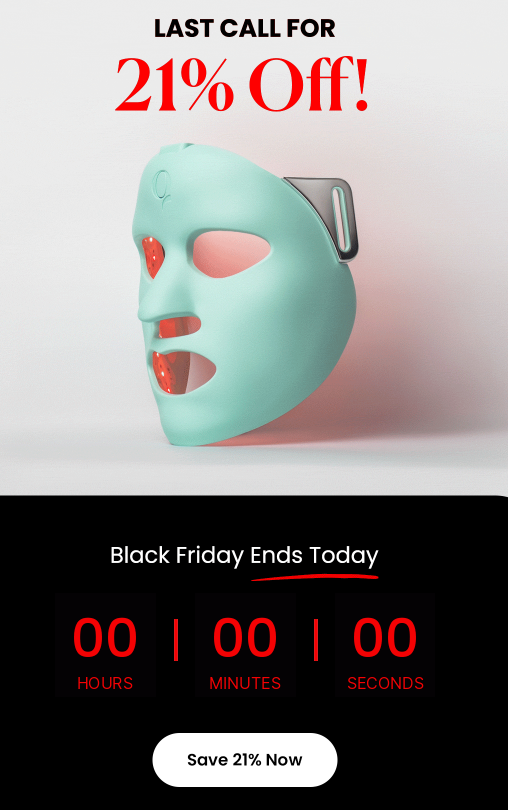
#1 | Most discounts cut into profit
20% or 30% off across the board sounds strong. But if your average order value (AOV) doesn’t go up, you’re just giving money away.
But if you increase AOV (for example, by encouraging people to buy more items with tiered discounts), you can run promos that drive more revenue without destroying margin.
We tested a tiered discount vs. a flat 15% across multiple brands.
The tiered offer (10% off 1, 15% off 2, 20% off 3) brought in 12% more revenue per recipient and 2x more orders — even with a BOGO50 deal already live.
#2 | Starting late means getting buried
Brands that waited until Black Friday to start talking to their list lost to the ones who started 2–3 weeks earlier.
What worked: Sending teasers and early access offers starting Nov 1 (or earlier).
One brand started Oct 26 and had over half their BFCM revenue in before Friday even hit.
#3 | Paid ads keep getting more expensive
Customer acquisition costs are rising every year. You can’t count on paid to carry Q4 without killing your margin.
The brands that made money during BFCM weren’t just running ads.
They had email flows already optimized, warm lists ready to buy, and SMS in place before the sale even launched.
In fact, 60% of the top-performing accounts had SMS contributing to owned revenue, and one account drove major results by sending 99 campaigns — 14 of them retargeting non-clickers.
#4 |Late prep, undermine the rush
Most brands launch BFCM cold. No warm-up. No early list building. And almost no segmentation ahead of time.
What worked: Brands that started teasing offers in late October and segmented their lists before November saw more opens, better clicks, and higher conversion all month long.
Early prep gives you more room to scale later.
Real Buyer Behavior You Can't Ignore
-
Roughly 197 million Americans shopped during the Thanksgiving–Cyber Monday stretch, spending an average of $235 each — more than last year
-
Nearly 75%+ of site visits and half of Cyber Monday sales came from mobile devices
-
Cyber Monday average order value (AOV) hit $124, but in some segments it actually dropped 4% vs. last year
-
BNPL accounted for nearly $1 billion in Cyber Monday U.S. sales alone (most on mobile)
-
About 47 million shoppers bought from Shopify-powered stores
-
Brands using AI features in personalization and recs saw around 9% higher conversion rates
Other BFCM stats you should consider:
-
The Middle East celebrates White Day, launched by the online retailer souq.com which sold 1.2 million products over the sale weekend in 2016.
-
China has Singles Day, which at one point surpassed BFCM sales by 4x in 2017. Even Australian consumers spent an estimated $150 million over the sale weekend.
-
UK and Muslim communities would have Ramadan which, aside from its religious significance, is also a hugely celebrated retail event.
-
Mexico has El Buen Fin where local stores also highlight big sales and discounts.
-
India has the Diwali Festival where shoppers spent $146 billion back in 2016.
CHAPTER 2
Email Benchmarks That Still Matter (And What Doesn’t Anymore)
If you’re sending emails but not tracking the right numbers, you’re flying blind and possibly losing money.
This section breaks down the benchmarks that still mean something today, and the ones that don’t.
What to track?
- Open rates
Still useful for checking list health.
→ Aim for 30%+ on campaigns, 40–60% on flows
→ Bad open rates usually mean poor targeting or weak subject lines - Click rates
Shows how many people actually care about your offer.
→ Aim for 2% or higher
→ If people aren’t clicking, they’re not buying - Flow revenue
Your automated emails should do the heavy lifting.
→ Target 30–50% of your total email revenue from flows like Welcome, Abandoned Cart, and Winback
What top-performing brands are doing
- Most campaigns were segmented
One high-revenue brand sent 99 BFCM campaigns — 85 of them went to segmented lists
→ Only 14 were retargeting sends to cold/openers who didn’t click - They changed flows during BFCM
The best accounts didn’t just “set and forget.”
→ Brands who updated flow copy and offers mid-sale saw up to 15% more revenue from flows - They used plain-text when it mattered
HTML for hype. Plain text for urgency.
→ This boosted deliverability, especially during high send volume periods
What to stop worrying about
- How many emails you send
Sending more doesn’t mean you’ll make more.
→ If your list is cold or unsegmented, you’re just burning reach - Open rates alone
Apple’s Mail Privacy Protection inflated these numbers.
→ Always look at clicks and revenue too - Monthly send limits
There’s no one-size-fits-all. Some brands sent 40+ emails during BFCM and still made money.
→ What matters is relevance and timing
Before you scale, ask:
- Are your flows just running, or actually converting?
- Do your segments reflect buyer behavior or just random tags?
- Are your promos building profit or just giving discounts away?
The infographic below breaks down key email flow benchmarks.
Use it as your baseline, but remember, good strategy beats average metrics.
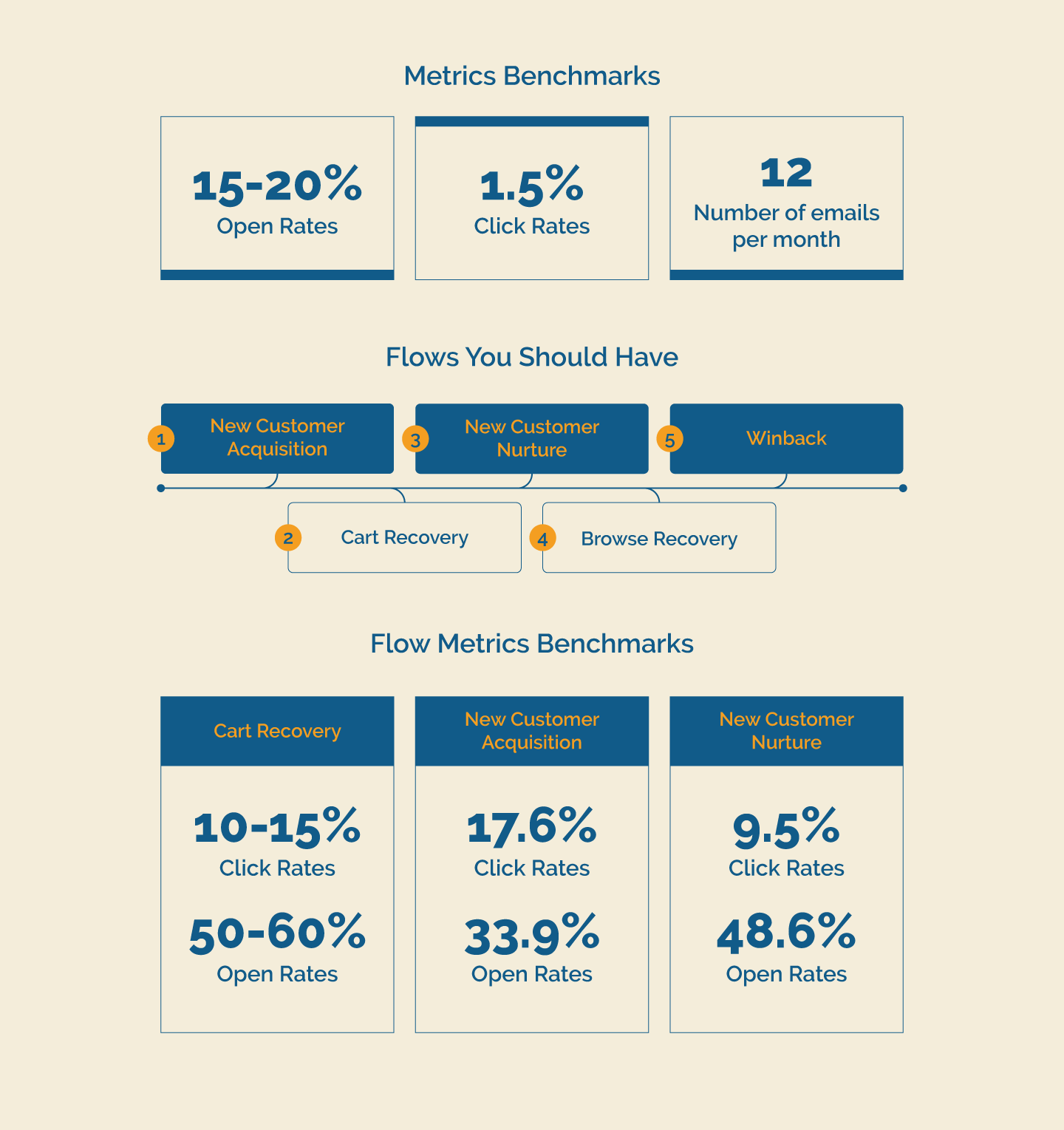
Why is open rate important?
This is the main metric that would tell you how often or how less your subscribers open your emails.
If your open rate is low, you can expect it could have something to do with your subject lines, preview text, send times, or even your sender name.
Why is click rate important?
Click rate can help you determine if subscribers are clicking the CTAs in your emails.
If you notice you have low click rates, you’ll need to revisit how to present your CTAs.
Are they clear and visible? Are they just embedded clickable text links or have visual button GFX? Should they be static clickable images or animated CTAs?
CHAPTER 3
BFCM Planning Calendar That Doesn’t Blow Up in November
When Should I Start Preparing for BFCM?
As a rule of thumb, you’ll need to start preparations as soon as Q2. You’re main concern, however, would be when to start your BFCM campaigns.
Based on our experience working with our clients, we’ve narrowed the best time to start your BFCM campaigns on as early as late October to mid-November.
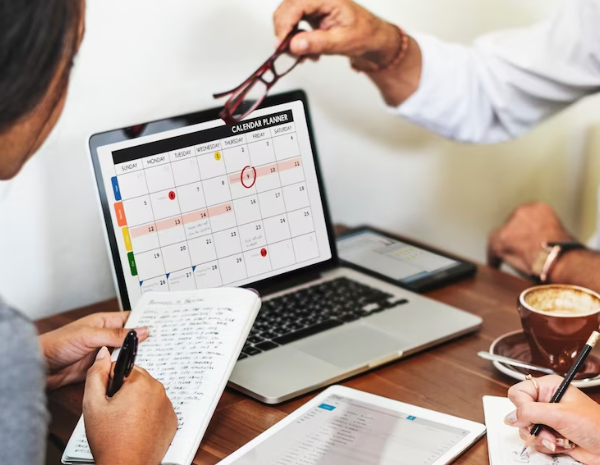
Here are some of the highlights from our clients who started their campaigns within that time range:

This means the revenue your campaigns would generate could potentially reach an average of 50% if you were to start your campaigns within this earlier time range.
Based on this recommended launch time, here’s a brief calendar plan breakdown of actionables for your BFCM prep beforehand:
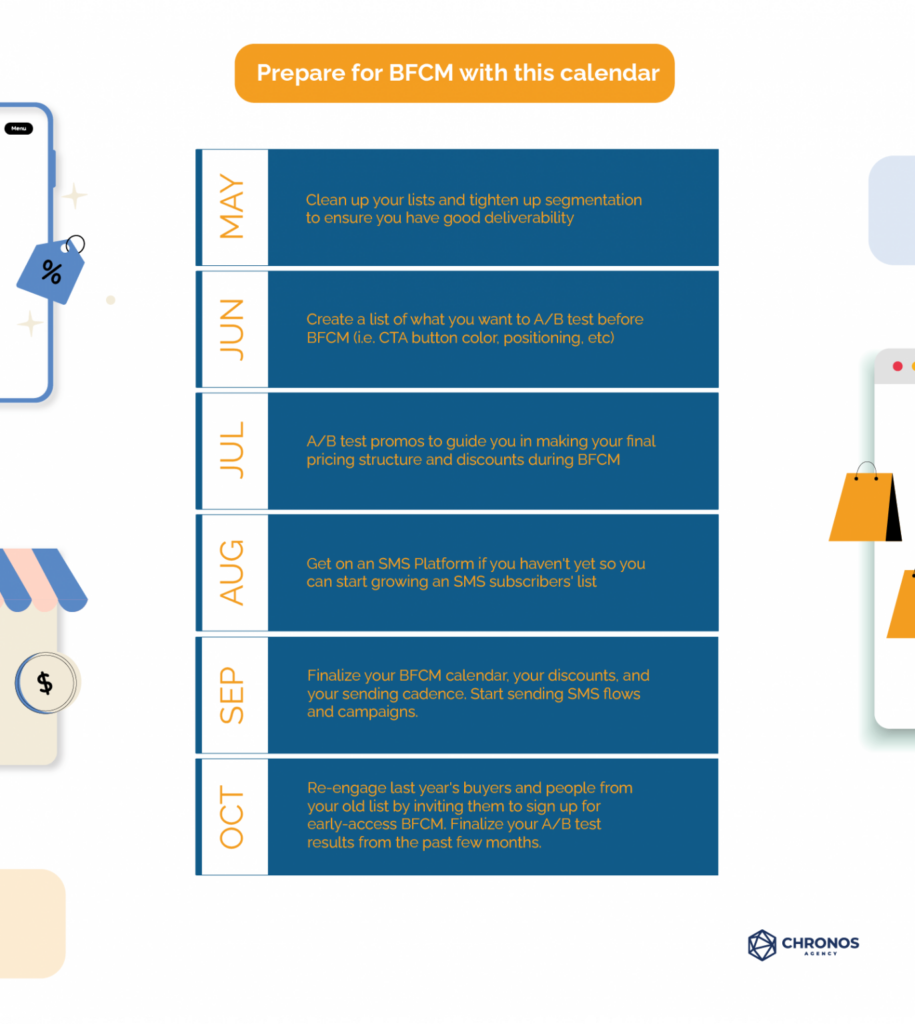
CHAPTER 4
What Winning BFCM Emails Actually Look Like
How Should my Emails Look?
You should be sending only the best of the best that your email marketing arsenal has to offer.
This is why we recommend you start your BFCM preparations as early as Q2, it’s to give you enough time to A/B test and optimize your emails accordingly.
Here’s a great example of how a winning email should look:
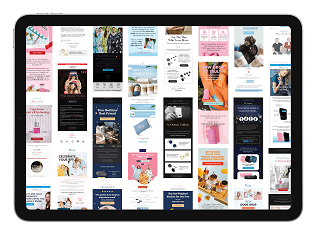
To take your emails further for BFCM, here are some quick tips to make your emails convert:
-
Maintain branding consistency
As much as possible, recreate your DTC brand’s website experience in your emails. -
Cater your emails to skimmers.
Break down long-form emails into easy-to-digest sections for higher readability. -
Have at least 2 to 3 ready-to-use email templates in your disposal.
This is so you can easily swap between based on your needs for maximum flexibility. -
Add a sense of urgency to your emails.
Pair up your big discount promos with clear time limits or animated countdown timers. -
Always test if your email’s multimedia assets display properly.
Check and double-check through different email service providers if your images, GIFs, or videos will display properly. -
Optimize your email deliverability
Spam filters are one of your major hurdles when it comes to email marketing. Only send relevant content to your subscribers to build and maintain your deliverability standing.

CHAPTER 5
What the Best-Owned Channel Strategies Have in Common
How do I use Email, SMS, and Push Notification Marketing Strategies for BFCM?
Email and SMS marketing is like a match made in heaven. Email’s high personalization and customizability paired with SMS’ high reach and almost guaranteed deliverability make up for each other’s weaknesses.
Top it all off with push notification marketing and you’ve got a recipe for success.
So, what strategies of each can you use to maximize your BFCM profits?
You can break down your overall BFCM marketing strategy into three major parts:
- Integrate exclusivity to make your customers feel valued and important
- Tease your customers about what’s coming up in your BFCM sale
- Use FOMO to make your customers feel like they’re losing something big by not signing up to your channels
- Lifestyle
For email marketing, the 6-Step Holiday Sales Sequence is something we’ve developed and applied in many of our clients’ email marketing systems—with promising results.
Essentially, this sequence is geared towards hyping up your audience, nurturing them throughout the sales event, and instilling urgency by the near end.
Here’s a brief breakdown of the process:
Step 1:Hype Up Your Customer Base
Your customers can get started browsing your store early and setting aside shopping funds. Having hype or teaser emails can also play a part in boosting your overall campaign revenue.
Based on our experience with our clients, brands who have teaser emails brought in more revenue than brands who opted not to.
Step 2:Segment Your VIPs and Regular Customers
VIPs also tend to regularly buy your products at full price as opposed to other customers who would only interact with your store during a big sale.
Step 3:Give Early Sale Access to Your VIPs
Reward your VIPs with exclusive early access to your sale. Doing this will also show how much your brand values its VIPs, further reinforcing their loyalty to your store.
Step 4:Execute Your Main Lunch for Your Regular Customers
It’s time to open the flood gates to the rest of your customer base. All the emails you’ve been optimizing, all the tactics and strategies you’ve been sharpening—it all leads to this moment.
Step 5: Send Social Reminders
These can range from product reviews and customer feedback to product demo videos. The main goal of using UGC is to educate your customers on how much of a positive impact your product will have on their lives.
Step 6: Close Your Sales with Urgency
The magic of this 6-step sequence is that you can freely apply this strategy to holidays outside of BFCM as well.
For SMS marketing, you can leverage these 3 creative strategies:
-
Boost Your List Growth with Exclusivity
Make some of your BFCM offers SMS exclusive, encouraging your customer base to opt-in to your SMS lists.
This way, you can add more value to your SMS channel rather than making it “sound” exactly like your other marketing channels. -
Help Your Customers Find the Perfect Gift with Gift Guides
Lessen the choice overload by sending your customers gift guides through your SMS channel. Keyword triggered SMS automation can also help your customers find relevant products—maintaining the relevance of your SMS messages which in turn encourages your customers to respond. -
Personalize Your Automations to Be More BFCM-specific
Keep your messages from being marked as spam by making your SMS flows reflect the BFCM sale. Give your customers what they’re expecting. So when they’re expecting BFCM messages, you must send them BFCM-related content.
For one, push notifications are permission-based. What this means is that people who allow them are already telling you they are very much interested in your brand’s products and content.
By the way, we observed that our clients with apps for their stores would generate 7% of their overall revenue. This is because apps act as a convenient way to access your store through their mobile devices.
On the other hand, they work effectively as reminders for your customers. Got some abandoned carts? Need to remind your customers that BFCM is almost over? Do some of your customers still have unused discount codes?
Push notifications guarantee that your customers see what you need them to see since they display as these big banners on their mobile device screens.
CHAPTER 6
Proven Offers, Real Tests, and Mistakes to Avoid
Aside from going for an earlier BFCM sale launch, here are other tactics you can consider based on our clients’ results from their BFCM performance:
Revisit Your Existing Flows and Have Them Reflect Your Holiday Discounts
Just as we mentioned in the SMS section, make sure that your automated flows reflect your current holiday.
This should maximize the relevance of your messages to your customers—minimizing spam flagging.
Expand Your Reach by Leveraging Omnichannel Marketing
This way, you can speak the language of your target audience no matter what platform they use—be it email, SMS, or social media.
Use the Best Practices when Offering Discounts
Why does this matter? Carefully planning your discounts can help you strike a balance between gains and losses, especially when dealing with different customer segments.
Make Your Emails Dynamic with a Combination of HTML and Text-based Emails
On the other hand, text-based emails are enough for important notification-type messages like reminder emails (cart recovery), company operation announcements, or personal messages.
Grow Your BFCM Mailing List Further with Website Pop-ups
Pop-ups can also help you monetize your website traffic—taking full advantage of the expected high BFCM traffic flow when the big sale event rolls in.

Key Takeaways
Use only the best strategies and collaterals your marketing can dish out from months of A/B testing. You shouldn't be A/B testing anything in the middle of BFCM.
Hype is key. Give your subscribers a huge headstart so they can start setting aside shopping funds and looking up what to buy from your store.
Prepare early. Nothing throws a wrench in your operations harder than avoidable issues that could have been ironed out earlier. Test your site and optimize your lists for a smoother sailing BFCM.
Launch early. Reward your most loyal customers with early exclusive access to your sale to maintain their strong relationship with your brand. This will also give your store a headstart on making sales BFCM sales—it’s a win-win!
Revisit your existing flows and align them with BFCM. You don’t have to make new flows from scratch. Save time and production by aligning your existing flows with BFCM.
